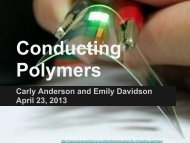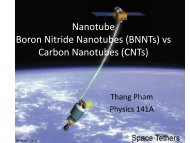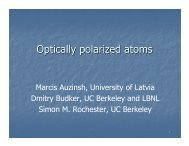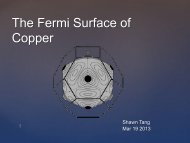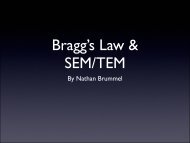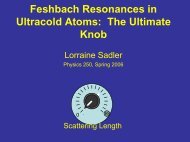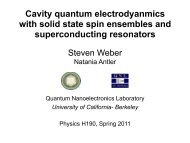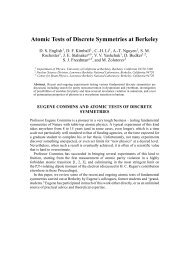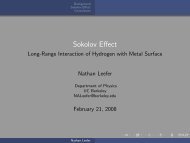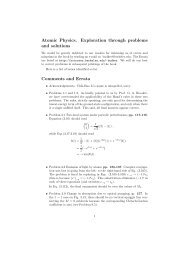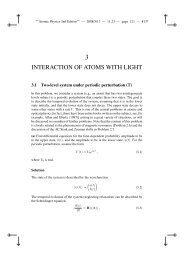Resonant nonlinear magneto-optical effects in atomsâ - The Budker ...
Resonant nonlinear magneto-optical effects in atomsâ - The Budker ...
Resonant nonlinear magneto-optical effects in atomsâ - The Budker ...
You also want an ePaper? Increase the reach of your titles
YUMPU automatically turns print PDFs into web optimized ePapers that Google loves.
33<br />
ization <strong>in</strong> the electric field (Fig. B.2). <strong>The</strong> maximum<br />
ellipticity <strong>in</strong>duced <strong>in</strong> the light field due to the coherence<br />
effect is proportional to ∆ s /γ rel .<br />
While much of the recent work on coherence NMOE<br />
has been done with alkali atoms, these are not necessarily<br />
the best choice for NEOE because tensor polarizabilities<br />
are suppressed for states with J = 1/2 as discussed <strong>in</strong><br />
Sec. XII.D.<br />
Herrmann et al. (1986) studied a different k<strong>in</strong>d of<br />
NEOE <strong>in</strong> which an electric field is applied to a sample<br />
of atoms, and normally forbidden two-photon transitions<br />
become allowed due to Stark mix<strong>in</strong>g. <strong>The</strong> large polarizabilities<br />
of Rydberg states make two-photon Stark spectroscopy<br />
of transitions <strong>in</strong>volv<strong>in</strong>g Rydberg levels an extremely<br />
sensitive probe for small electric fields.<br />
XI. EXPERIMENTAL TECHNIQUES<br />
In this Section, we give details of some of the experimental<br />
techniques that are employed for achiev<strong>in</strong>g long<br />
ground-state relaxation times (atomic beams with separated<br />
light-<strong>in</strong>teraction regions, buffer-gas cells, and cells<br />
with antirelaxation wall coat<strong>in</strong>g), as well as the techniques<br />
used for sensitive detection of NMOE and NEOE,<br />
especially spectropolarimetry (Sec. XI.B).<br />
We beg<strong>in</strong> the discussion by describ<strong>in</strong>g a representative<br />
experimental setup (Sec. XI.A). Us<strong>in</strong>g this example<br />
we formulate some general requirements for experimental<br />
apparatus of this sort, [for example, laser frequency tunability<br />
and stability (Sec. XI.E), and magnetic shield<strong>in</strong>g<br />
(Sec. XI.D)], and outl<strong>in</strong>e how these requirements have<br />
been met <strong>in</strong> practice.<br />
A. A typical NMOE experiment<br />
Here we give an overview of the Berkeley NMOE apparatus,<br />
which has been used to <strong>in</strong>vestigate various aspects<br />
of the physics and applications of narrow (∼2π ×1-Hz,<br />
<strong>Budker</strong> et al., 1998a) resonances, such as alignment-toorientation<br />
conversion (<strong>Budker</strong> et al., 2000a), self rotation<br />
(Rochester et al., 2001), and reduced group velocity<br />
of light (<strong>Budker</strong> et al., 1999a). <strong>The</strong> setup has also been<br />
used to <strong>in</strong>vestigate NEOE and to conduct exploratory<br />
experiments whose ultimate goal is test<strong>in</strong>g fundamental<br />
symmetries (Kimball et al., 2001; Yashchuk et al., 1999a).<br />
Due to the large enhancement of small-field <strong>optical</strong> rotation<br />
produced by the narrow resonance, this setup is a<br />
sensitive low-field <strong>magneto</strong>meter (<strong>Budker</strong> et al., 2000b).<br />
With a few modifications, this apparatus can also be applied<br />
to extremely high-sensitivity <strong>magneto</strong>metry <strong>in</strong> the<br />
Earth-field range (<strong>Budker</strong> et al., 2002b).<br />
<strong>The</strong> Berkeley apparatus is shown <strong>in</strong> Fig. XI.A.<br />
Rubidium and/or cesium atoms are conta<strong>in</strong>ed <strong>in</strong> a vapor<br />
cell with paraff<strong>in</strong> coat<strong>in</strong>g (Alexandrov et al., 1996),<br />
used to suppress relaxation of atomic ground-state polarization<br />
<strong>in</strong> wall collisions (Sec. VIII.E). <strong>The</strong> experiments<br />
FIG. 19 Schematic diagram of the modulation polarimetrybased<br />
experimental setup used by <strong>Budker</strong> et al. (1998a) to<br />
<strong>in</strong>vestigate NMOE <strong>in</strong> paraff<strong>in</strong>-coated alkali-metal-vapor cells.<br />
are performed on the D1 and D2 resonance l<strong>in</strong>es. A<br />
tunable extended-cavity diode laser is used as the light<br />
source. <strong>The</strong> laser frequency is actively stabilized and can<br />
be locked to an arbitrary po<strong>in</strong>t on the resonance l<strong>in</strong>e us<strong>in</strong>g<br />
the dichroic-atomic-vapor laser-lock technique (Sec.<br />
XI.E). <strong>The</strong> laser l<strong>in</strong>e width, measured with a Fabry-<br />
Perot spectrum analyzer, is ≤7 MHz. Optical rotation is<br />
detected with a conventional spectropolarimeter us<strong>in</strong>g a<br />
polarization-modulation technique (Sec. XI.B). <strong>The</strong> polarimeter<br />
<strong>in</strong>corporates a crossed Glan prism polarizer and<br />
polariz<strong>in</strong>g beam splitter used as an analyzer. A Faraday<br />
glass element modulates the direction of the l<strong>in</strong>ear polarization<br />
of the light at a frequency ω m ≃ 2π×1 kHz with<br />
an amplitude ϕ m ≃ 5×10 −3 rad. <strong>The</strong> first harmonic of<br />
the signal from the photodiode <strong>in</strong> the darker channel of<br />
the analyzer, is detected with a lock-<strong>in</strong> amplifier. It is<br />
proportional to the angle of the <strong>optical</strong> rotation caused<br />
by the atoms <strong>in</strong> the cell, ϕ s (Sec. XI.B). This signal,<br />
normalized to the transmitted light power detected <strong>in</strong><br />
the brighter channel of the analyzer, is a measure of the<br />
<strong>optical</strong> rotation <strong>in</strong> the vapor cell.<br />
A coated 10-cm-diameter cell conta<strong>in</strong><strong>in</strong>g the alkali vapor<br />
is placed <strong>in</strong>side a four-layer magnetic shield and<br />
surrounded with three mutually perpendicular magnetic<br />
coils (Yashchuk et al., 2002a). <strong>The</strong> three outer layers<br />
of the shield are nearly spherical <strong>in</strong> shape, while the <strong>in</strong>nermost<br />
shield is a cube (this facilitates application of<br />
uniform fields to the cell). <strong>The</strong> shield provides nearly<br />
isotropic shield<strong>in</strong>g of external dc fields by a factor of<br />
∼10 6 (Yashchuk et al., 2002a). Although a very primitive<br />
degauss<strong>in</strong>g procedure is used (Sec. XI.D), the residual<br />
magnetic fields averaged over the volume of the vapor<br />
cell are typically found to be at a level of several microgauss<br />
(before compensation with the magnetic coils).



